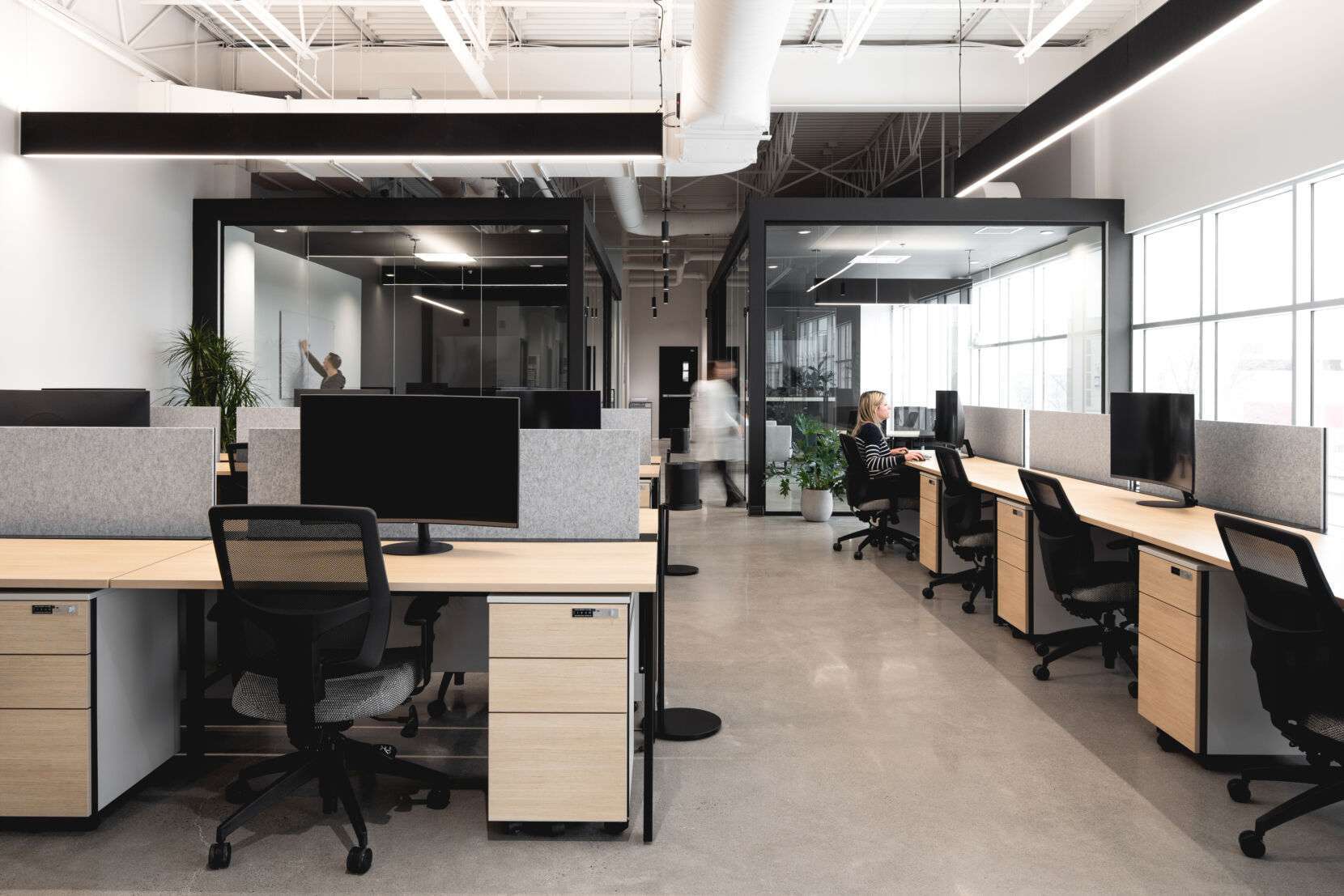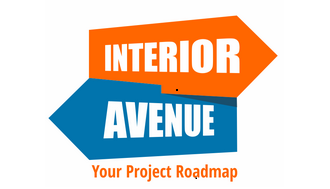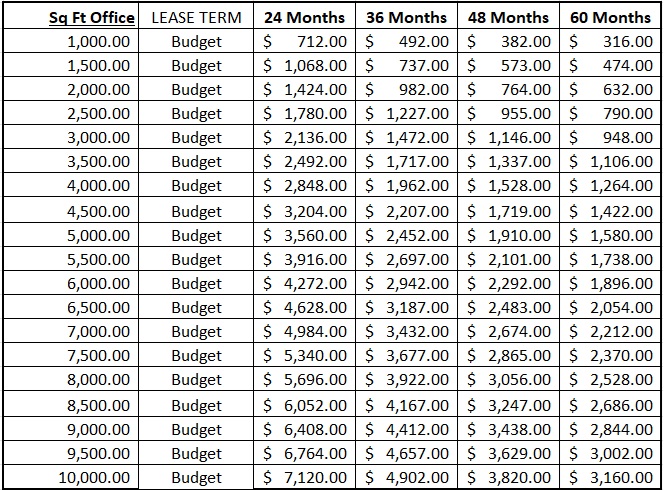How Movable Office Furniture Can Transform Your Phoenix Office
The design of an office can significantly influence productivity and adaptability. A well-thought-out office layout does more than just house your workforce; it enhances workflow, boosts employee morale, and adapts to the ever-changing needs of the business. This is particularly true in Phoenix, AZ, where the dynamic business environment demands flexibility and efficiency.
Enter movable office furniture—a trend that’s transforming workplaces by offering unparalleled flexibility. In Phoenix, where startups and established businesses thrive in a climate of innovation, movable furniture has become a cornerstone of modern office design. The benefits of this flexible furniture solution extend beyond simple aesthetics or surface-level functionality. Businesses that have embraced movable office furniture report not just improved space utilization but also a remarkable increase in productivity. In fact, studies show that companies that invest in adaptable office setups can see productivity boosts of up to 20%. This statistic underscores the significant impact that the physical environment has on an organization’s overall effectiveness.
By integrating movable office furniture, Phoenix businesses are not only staying ahead of design trends but are also crafting spaces that can evolve with their growth and changing needs. Let’s explore how movable office furniture is shaping the future of work in Phoenix, making offices more adaptive, and why your business might want to consider making the shift.

Office Furniture Rental Subscription
Understanding Movable Office Furniture
Movable office furniture refers to pieces designed to be easily relocated, reconfigured, or adjusted to suit various needs and spaces within a workplace. Examples of such furniture include adjustable desks that can transition from sitting to standing heights, modular seating arrangements that can be quickly rearranged for collaborative projects or individual work, and mobile storage units that can be moved as needed without disrupting the workflow. This category also encompasses items like rolling file cabinets and portable partitions that help redefine spaces effortlessly and on demand.
The core appeal of movable office furniture lies in its versatility and functionality. In the modern office, needs can change rapidly—from hosting a large team meeting to breaking down into smaller, focused groups. Movable furniture facilitates these shifts seamlessly, enabling a single space to accommodate multiple uses throughout the day. Adjustable desks, for example, allow employees to alter their working positions, which can lead to increased comfort and reduced physical strain, potentially boosting productivity and employee satisfaction. Modular seating can transform a casual meeting space into a formal presentation area with minimal effort. Similarly, mobile storage solutions help maintain organization and accessibility without sacrificing flexibility.
The functionality of movable furniture extends beyond physical reconfiguration. It supports the philosophical shift many companies are making towards dynamic and adaptable work environments. By integrating furniture that can easily adapt to different tasks and team sizes, businesses can create spaces that truly support the way modern work is evolving. This adaptability is particularly crucial in today’s business environment, where the ability to pivot quickly can be a significant competitive advantage.
Why Mobility Matters in Phoenix Offices
Phoenix, Arizona, is a burgeoning hub for innovation and entrepreneurship, with a diverse business landscape that ranges from burgeoning tech startups to expansive corporate entities. The city’s economic environment is characterized by rapid growth and transformation, driving a demand for office spaces that can adapt as quickly as the businesses they house. Flexible workspaces are not just a trend here; they are a fundamental component of the local business ethos. This agility is particularly crucial for tech startups, which must be able to scale up operations swiftly or pivot their business model based on market feedback and technological advancements.
The concept of mobility in office design plays a pivotal role in supporting this kind of business agility. Movable office furniture allows for quick reconfigurations of workspaces, facilitating everything from spontaneous brainstorming sessions to major organizational changes without significant downtime. This capability is vital for keeping pace with the fast-moving tech sector and other dynamic fields prevalent in the Phoenix area. Moreover, the flexibility to alter work environments easily also contributes significantly to employee satisfaction and retention. Workers in adaptable spaces report higher levels of job satisfaction, likely because these environments cater to diverse working styles and promote a healthier, more engaging workplace.
As businesses in Phoenix continue to evolve, the ability to modify office layouts with minimal effort allows companies to respond to changing operational requirements and employee preferences efficiently. This responsiveness not only boosts productivity but also enhances the overall workplace culture, making companies more attractive to top talent who seek flexible and innovative work environments.

Office Cubicles Phoenix
Key Benefits of Movable Office Furniture
Flexibility and Scalability: Movable office furniture epitomizes flexibility and scalability, two essential characteristics in today’s ever-evolving business environment. For organizations that experience frequent changes in team size, project scope, or operational focus, movable furniture provides a practical solution. It supports office reconfiguration for various purposes, from creating open spaces for all-hands meetings to partitioning areas for concentrated project work. As a business grows or shifts direction, movable furniture can easily be adapted to accommodate these changes, eliminating the need for expensive renovations or purchases of new, static pieces. This adaptability ensures that the physical workspace can keep up with the company’s development without additional resource strain.
Enhanced Collaboration: The ability to reconfigure office spaces on the fly also significantly enhances collaboration and communication within teams. Movable furniture like modular workstations, movable walls, and mobile chairs can be quickly rearranged to create collaborative environments that encourage openness and teamwork. This flexibility not only fosters a more inclusive and interactive work atmosphere but also allows employees to shift seamlessly between individual tasks and group projects, promoting an agile work culture. In an age where collaboration is key to innovation, having an adaptable office layout can be a critical factor in fostering creative problem-solving and effective team dynamics.
Health and Ergonomics: From an ergonomic perspective, movable office furniture offers substantial benefits that contribute to employee health and well-being. Adjustable desks that allow for both sitting and standing work positions can help reduce the risk of chronic health issues associated with prolonged sitting, such as back pain and cardiovascular problems. Ergonomic chairs that can be adjusted to suit individual needs also help prevent strain and injuries, ensuring that employees are comfortable and less prone to work-related health issues. This focus on ergonomics not only promotes a healthier workplace but can also lead to reduced absenteeism and increased productivity.
Cost-Effectiveness: Investing in movable office furniture can lead to significant long-term savings for businesses. While the initial cost might be higher than traditional, fixed installations, the versatility of movable furniture means that a company can adapt to changes without incurring the costs associated with buying new furniture or renovating spaces. This ability to repurpose and rearrange existing furniture reduces waste and expenses over time. Additionally, movable furniture often features durable design and materials to withstand frequent changes and relocations, offering better longevity and value for money compared to fixed furniture solutions.
These key benefits demonstrate how movable office furniture is not only a practical choice for today’s dynamic business environments but also a strategic investment in a company’s future growth and efficiency.
Real-Life Applications in Phoenix
Case Study 1: Tech Solutions, Phoenix Tech Solutions, a rapidly expanding software company based in Phoenix, stands as a testament to the successful implementation of movable office furniture. With an agile workforce that often fluctuates in size based on project demands, the company adopted a flexible office setup using movable furniture to quickly adapt to changing needs. They incorporated modular desks and mobile dividers that allow the workspace to be reconfigured from collaborative spaces during brainstorming sessions to individual workstations for heads-down programming. The result has been overwhelmingly positive: Tech Solutions has not only seen an improvement in team dynamics but also a reduction in the downtime typically associated with reorganizing physical spaces. Their ability to swiftly adapt the office layout has facilitated smoother transitions between different phases of project work, enhancing overall productivity and employee satisfaction.
Case Study 2: Interview with Maya Jensen, Phoenix Office Designer Lori Alvarado, a renowned office designer, shares her insights on the impact of movable office furniture on client satisfaction and office aesthetics. Over the past few years, Lori has helped several Phoenix businesses transition from static to dynamic workspaces by integrating movable furniture solutions. According to Lori, the adoption of movable furniture has significantly increased client satisfaction rates. Her clients report that flexible furniture options provide their employees with the ability to personalize their work environment according to their daily needs, which has not only boosted morale but also enhanced the visual appeal of their offices. Lori notes that movable furniture allows for easy updates to office aesthetics without major renovations, helping companies maintain a modern and engaging environment. The adaptability of movable furniture, she observes, encourages a fresher, more vibrant workplace that aligns with contemporary design trends, making these offices attractive places to work.
These real-life examples from Phoenix highlight the practical benefits and transformative potential of movable office furniture in creating more adaptable, efficient, and visually appealing work environments.

Office Furniture Phoenix Conference Room and Tables
Choosing the Right Movable Furniture for Your Office
Assessing Needs: Selecting the right movable furniture for your office begins with a thorough assessment of your specific needs and the preferences of your employees. Start by understanding the nature of your work and the daily activities that your space needs to support. Consider factors such as the number of employees, the type of work they do (collaborative vs. individual tasks), and how often your team configuration might change. It’s also essential to gather input directly from your employees. What do they feel is lacking in the current setup? What features would enhance their productivity and comfort? Engaging with your team not only helps in making informed decisions but also boosts morale by showing that their input is valued. This collaborative approach ensures that the furniture chosen will effectively meet the demands of both the tasks at hand and the people performing them.
Material and Quality Considerations: When selecting movable furniture, it’s crucial to consider the durability and quality of materials, especially in a climate like Phoenix’s, which can involve extreme temperatures. Opt for materials that can withstand significant wear and tear without deteriorating. Metals with a high-quality powder coat finish, for instance, can resist scratching and corrosion, making them ideal for frequently reconfigured items. Similarly, choose upholstery that is resistant to fading from sunlight, a common issue in sun-drenched areas. Investing in high-quality materials might be more costly upfront but will prove more economical in the long run due to their longevity and lower maintenance requirements.
Space Planning: Effective space planning is vital when incorporating movable furniture into your office design. The goal is to maximize the use of space while maintaining flexibility. Begin by creating a floor plan that allows for easy movement and multiple configurations. Ensure there is ample space for pathways and that furniture can be moved or adjusted without obstruction. Consider the placement of power sources and how they can best support various layouts—using floor-mounted power docks, for example, can keep cables managed but accessible. It’s also beneficial to implement zones that can be easily transformed from individual work areas to collaborative spaces as needed. Utilizing movable dividers or acoustic panels can help in dynamically defining these zones. Thoughtful space planning not only enhances mobility and efficiency but also contributes to a safer and more productive work environment.
By carefully assessing needs, choosing the right materials, and thoughtfully planning your space, you can select movable office furniture that not only meets your current requirements but also adapts to future changes, ensuring a lasting and flexible office environment.
Implementation Tips and Best Practices
Step-by-Step Guide on Integrating Movable Furniture into an Existing Office Setup: Introducing movable furniture into an existing office environment requires careful planning and execution. Begin by conducting an inventory of your current furniture and assessing what can be replaced or supplemented with movable pieces. Next, design a phased plan that minimizes disruption to daily operations. Start small by introducing key pieces that offer the most immediate benefits, such as adjustable desks or mobile storage units. Gradually phase in additional movable elements, such as modular seating and portable partitions, as employees become accustomed to the new setup. Throughout this process, maintain clear communication with your team, explaining the benefits and providing training on how to adjust and move the new furniture. It’s also crucial to solicit feedback during each phase to make necessary adjustments and ensure the furniture meets everyone’s needs effectively.
Common Challenges and Solutions in Transitioning to a Mobile Office Environment: Transitioning to a mobile office setup can present several challenges, including resistance from employees used to a static environment, logistical issues in arranging mobile units, and maintaining aesthetics and functionality. To overcome resistance, it’s essential to engage with employees throughout the transition process, emphasizing the benefits and seeking their input on the choice and arrangement of movable furniture. For logistical challenges, work with a professional office designer or an experienced vendor who can provide insights into the best practices for furniture placement and mobility. They can help design a layout that maximizes the utility of movable pieces while ensuring the office remains organized and aesthetically pleasing. Additionally, invest in training for your staff to handle, move, and adjust furniture as needed, which will help maintain functionality and extend the life of the pieces. Lastly, address aesthetic concerns by choosing furniture that not only serves functional purposes but also enhances the office’s overall design. Opt for colors and styles that complement your existing décor to create a cohesive look even as the configuration of the space changes.
By following these steps and addressing common challenges with thoughtful solutions, businesses can smoothly transition to a more flexible and dynamic office environment. This approach ensures that the integration of movable furniture brings about the intended improvements in productivity, collaboration, and employee satisfaction.

Office Furniture Large Glass Conference Room Open Plan Desks Mesh Chairs Planter
Future Trends in Office Mobility
As workplaces continue to evolve, office furniture design is poised to meet these changes with innovative solutions that prioritize mobility, adaptability, and technology integration. One upcoming trend is the integration of smart technology with movable office furniture. Imagine desks and workstations equipped with built-in sensors that adjust their height automatically based on the user’s preset preferences or usage patterns. Additionally, furniture may incorporate IoT (Internet of Things) capabilities to allow for remote adjustments and monitoring, enabling optimal configurations for energy efficiency and user comfort.
Another trend likely to gain traction is the use of lightweight, durable materials that make furniture easier to move and reconfigure. Advances in material science could introduce furniture that changes shape and function through minimal user interaction, perhaps using memory polymers that can shift between pre-set configurations. This would further enhance the flexibility and scalability of office spaces, catering to various activities and team sizes with unprecedented ease.
Predicting Phoenix’s Influence on Movable Furniture Trends
The needs of Phoenix businesses, characterized by a blend of high-tech industries, creative sectors, and entrepreneurial ventures, will significantly influence the direction of movable office furniture design. Phoenix’s rapid business growth and the premium on innovation demand office environments that are not just functional but also conducive to creativity and rapid development cycles. We can anticipate a demand for modular environments that can be quickly reconfigured not only physically but also technologically. This could manifest in multipurpose pieces that serve various functions— from interactive, tech-enabled meeting areas to quiet, privacy-assured pods that foster concentration.
Additionally, as Phoenix continues to attract a diverse workforce, the emphasis on inclusive design will grow. Furniture that can be customized to meet the ergonomic needs of a diverse population will be paramount. This includes adjustable features that cater to various body types and abilities, enhancing comfort and accessibility. As environmental concerns remain at the forefront, Phoenix businesses will also drive demand for eco-friendly movable furniture, crafted from sustainable materials and designed for longevity.
The future of office mobility in Phoenix looks to be an exciting fusion of technology, sustainability, and user-centric design, reflecting the city’s dynamic spirit and its business community’s innovative mindset.

Breakroom Furniture Phoenix






Leave a reply